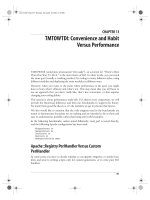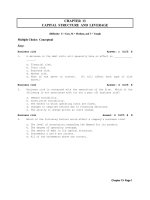chapter 13 game theory and competitive strategy
Bạn đang xem bản rút gọn của tài liệu. Xem và tải ngay bản đầy đủ của tài liệu tại đây (352.97 KB, 79 trang )
Chapter 13
Game Theory
and Competitive
Strategy
Chapter 13 Slide 2
Topics to be Discussed
Gaming and Strategic Decisions
Dominant Strategies
The Nash Equilibrium Revisited
Repeated Games
Chapter 13 Slide 3
Topics to be Discussed
Sequential Games
Threats, Commitments, and Credibility
Entry Deterrence
Bargaining Strategy
Chapter 13 Slide 4
Gaming and Strategic Decisions
“If I believe that my competitors are
rational and act to maximize their own
profits, how should I take their behavior
into account when making my own
profit-maximizing decisions?”
Definition of a game
Chapter 13 Slide 5
Gaming and Strategic Decisions
Noncooperative versus Cooperative
Games
Cooperative Game
Players negotiate binding contracts that
allow them to plan joint strategies
Example: Buyer and seller negotiating the
price of a good or service or a joint venture
by two firms (i.e. Microsoft and Apple)
Binding contracts are possible
Chapter 13 Slide 6
Gaming and Strategic Decisions
Noncooperative versus Cooperative
Games
Noncooperative Game
Negotiation and enforcement of a
binding contract are not possible
Example: Two competing firms assuming
the others behavior determine,
independently, pricing and advertising
strategy to gain market share
Binding contracts are not possible
Chapter 13 Slide 7
Gaming and Strategic Decisions
Noncooperative versus Cooperative
Games
“The strategy design is based on
understanding your opponent’s point of
view, and (assuming you opponent is
rational) deducing how he or she is likely to
respond to your actions”
Chapter 13 Slide 8
Dominant Strategies
Dominant Strategy
One that is optimal no matter what an
opponent does.
An Example
A & B sell competing products
They are deciding whether to undertake
advertising campaigns
Chapter 13 Slide 9
Payoff Matrix for Advertising Game
Firm A
Advertise
Don’t
Advertise
Advertise
Don’t
Advertise
Firm B
10, 5 15, 0
10, 26, 8
Chapter 13 Slide
10
Payoff Matrix for Advertising Game
Firm A
Advertise
Don’t
Advertise
Advertise
Don’t
Advertise
Firm B
10, 5 15, 0
10, 26, 8
Observations
A: regardless of
B, advertising is
the best
B: regardless of
A, advertising is
best
Chapter 13 Slide
11
Payoff Matrix for Advertising Game
Firm A
Advertise
Don’t
Advertise
Advertise
Don’t
Advertise
Firm B
10, 5 15, 0
10, 26, 8
Observations
Dominant
strategy for A &
B is to advertise
Do not worry
about the other
player
Equilibrium in
dominant
strategy
Chapter 13 Slide
12
Dominant Strategies
Game Without Dominant Strategy
The optimal decision of a player without a
dominant strategy will depend on what the
other player does.
Chapter 13 Slide
13
10, 5 15, 0
20, 26, 8
Firm A
Advertise
Don’t
Advertise
Advertise
Don’t
Advertise
Firm B
Modified Advertising Game
Chapter 13 Slide
14
10, 5 15, 0
20, 26, 8
Firm A
Advertise
Don’t
Advertise
Advertise
Don’t
Advertise
Firm B
Modified Advertising Game
Observations
A: No dominant
strategy;
depends on B’s
actions
B: Advertise
Question
What should A
do? (Hint:
consider B’s
decision
Chapter 13 Slide
15
The Nash Equilibrium Revisited
Dominant Strategies
“I’m doing the best I can no matter what
you do.”
“You’re doing the best you can no matter
what I do.”
Chapter 13 Slide
16
The Nash Equilibrium Revisited
Nash Equilibrium
“I’m doing the best I can given what you
are doing”
“You’re doing the best you can given what I
am doing.”
Chapter 13 Slide
17
Examples With A Nash Equilibrium
Two cereal companies
Market for one producer of crispy cereal
Market for one producer of sweet cereal
Each firm only has the resources to
introduce one cereal
Noncooperative
The Nash Equilibrium Revisited
Product Choice Problem
Product Choice Problem
Chapter 13 Slide
18
Product Choice Problem
Firm 1
Crispy Sweet
Crispy
Sweet
Firm 2
-5, -5 10, 10
-5, -510, 10
Chapter 13 Slide
19
Product Choice Problem
Firm 1
Crispy Sweet
Crispy
Sweet
Firm 2
-5, -5 10, 10
-5, -510, 10
Question
Is there a Nash
equilibrium?
If not, why?
If so, how can
it be reached
Chapter 13 Slide
20
The Nash Equilibrium Revisited
Maximin Strategies
Scenario
Two firms compete selling file-encryption
software
They both use the same encryption
standard (files encrypted by one
software can be read by the other -
advantage to consumers)
Chapter 13 Slide
21
The Nash Equilibrium Revisited
Maximin Strategies
Scenario
Firm 1 has a much larger market share
than Firm 2
Both are considering investing in a new
encryption standard
Chapter 13 Slide
22
Maximin Strategy
Firm 1
Don’t invest Invest
Firm 2
0, 0 -10, 10
20, 10-100, 0
Don’t invest
Invest
Chapter 13 Slide
23
Maximin Strategy
Firm 1
Don’t invest Invest
Firm 2
0, 0 -10, 10
20, 10-100, 0
Don’t invest
Invest
Observations
Dominant
strategy Firm 2:
Invest
Nash equilibrium
Firm 1: invest
Firm 2: Invest
Chapter 13 Slide
24
Maximin Strategy
Firm 1
Don’t invest Invest
Firm 2
0, 0 -10, 10
20, 10-100, 0
Don’t invest
Invest
Observations
If Firm 2 does
not invest, Firm
1 incurs
significant
losses
Firm 1 might
play don’t invest
Minimize
losses to 10
maximin
strategy
Chapter 13 Slide
25
If both are rational and informed
Both firms invest
Nash equilibrium
The Nash Equilibrium Revisited
Maximin Strategy
Maximin Strategy









